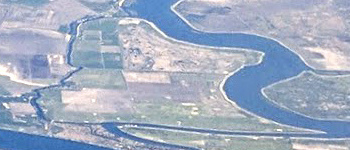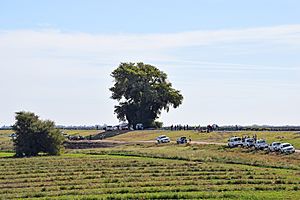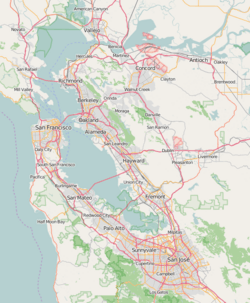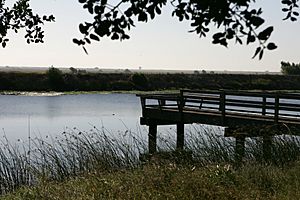Twitchell Island facts for kids

Twitchell Island in an aerial photo taken looking toward the east in 2018.
|
|
| Geography | |
|---|---|
| Location | Northern California |
| Coordinates | 38°06′35″N 121°38′55″W / 38.109641°N 121.648565°W |
| Adjacent bodies of water | Sacramento-San Joaquin River Delta |
| Area | 3,000 acres (1,200 ha) |
| Highest elevation | -2 ft (-0.61 m) |
| Administration | |
| State | |
| County | Sacramento |
| City | Isleton |

Twitchell Island is an island located in the Sacramento-San Joaquin River Delta in Sacramento County, California. It is about 35 kilometers (22 miles) southwest of the city of Sacramento. This island is quite unique because it sits about 2 meters (6.5 feet) below sea level.
The island is surrounded by water on all sides. To the north, you'll find Seven Mile Slough. The San Joaquin River borders the island to the east and south. On the west, it's next to Three Mile Slough. Most of Twitchell Island, about 85%, is owned by the State of California.
Saving Sinking Land
Twitchell Island is home to an important science experiment. The U.S. Geological Survey (a government science agency) is studying how to stop the land from sinking. Many islands in the Sacramento Delta are slowly losing ground. This happens because of wind, rain, and years of farming.
Nature's Solution
Scientists are trying a natural solution: growing special plants called tules and cattails. These plants are like tall grasses that grow in wet areas. The experiment started in 1996. Since then, the soil in the 15-acre (6-hectare) test area has actually risen by 0.3 to 0.6 meters (1 to 2 feet)! This shows that these plants can help rebuild the land.
Plants and Climate Change
These plants do more than just raise the land. They also help fight climate change. How? They "sequester" carbon. This means they pull carbon dioxide, a greenhouse gas, out of the air and store it in their leaves, stems, and roots. This helps clean the air.
Farmers in the Delta might even be able to earn money by planting tules and cattails instead of regular crops. This idea is called "carbon-capture farming." Companies that need to reduce their greenhouse gas emissions could pay farmers for the carbon stored by these plants. It's a win-win for the environment and for farmers!






